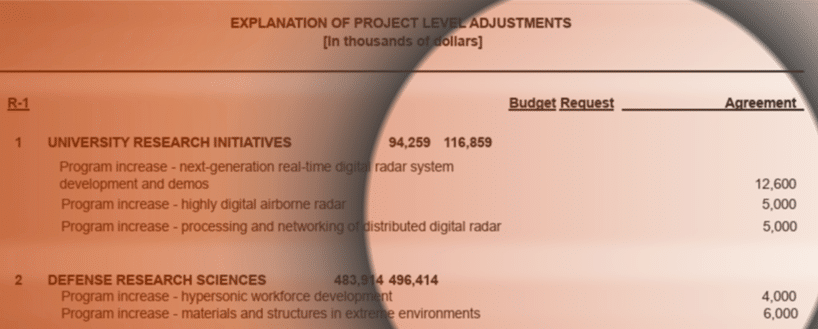TCS President Steve Ellis is joined by Budget Watchdog AF’s very own Josh Sewell to reveal the secrets of the awe-inspiring, disappearing debt limit trick. Magic or optical illusion? And the real truth about infrastructure and reconciliation.
Listen here or scroll down to read a transcript
Episode 11 — Transcript
[INTRO]Steve Ellis:
It’s August 2021, and the US Senate has just proved that summer vacation remains a qualifying deadline for action on Capitol Hill. Who said big things don’t happen in Washington, DC in the middle or even late in the summer? Well, the $1 trillion bipartisan infrastructure package passed with 69 votes. It’s not the whole way home, but this measure has rounded the corner with some momentum. But momentum is exactly what our first topic today does not have.
Steve Ellis:
I’m calling in Budget Watchdog AF’s very own Josh Sewell to help reveal the secrets of the awe-inspiring, disappearing debt limit trick. Magic, or optical illusion? How do they make it disappear and reappear like that before our very eyes? Years ago, I asked a con artist on Bourbon Street in New Orleans about the games, and he told me the games are for sell, not for tell, but Josh, I hope you do tell on the lawmakers playing the games. With that introduction, TCS senior policy analyst and Budget Watchdog AF frequent flyer, Josh Sewell. Welcome back to the podcast. I’m calling this segment D is for Debt Limit. You like?
Josh Sewell:
Sounds like a murder mystery. I love it. Let’s begin, shall we?
Steve Ellis:
Indeed. Listeners, you need to understand that the audacity of this stunt alone makes it worthy of David Blaine or David Copperfield. Never before and quite possibly never again has something so big just vanished before our very eyes, the debt. The debt? $28 trillion? That’s bigger than making a 747 or the Statue of Liberty disappear. Something those other tricksters claim to have done. Do tell, Josh.
Josh Sewell:
Well, okay. Not the debt. And I guess really the trick started a couple of years ago in the Bipartisan Budget Act of 2019.
Steve Ellis:
Bipartisan, So both sides were in on the con.
Josh Sewell:
So was then President Trump, and taxpayers were the mark. See, it used be that when the federal government had borrowed and spent enough, they would bump up against the total amount of debt that the government could accrue, set by law. If they wanted to continue borrowing to spend, then lawmakers would have to vote to increase the debt limit.
Steve Ellis:
Well, there was the Gephardt rule, named for the former Democratic House Majority Leader, that indicated the House voted to automatically suspend the debt limit when they pass the budget resolution and recalculate it to be the current debt plus what was going to be spent.
Josh Sewell:
All right, you really lived the eighties. So please tell. Okay,
Steve Ellis:
Okay. That was adopted in 1979 before my time, Josh, and enjoyed some form of modified bipartisan support over the years, but it was repealed in 2011 by the then Republican majority, the same Congress that adopted the Budget Control Act. Whoops, I’m stepping on the next podcast. Be ready, dear listener. We’re going to get into some of the impacts and goings on from the last big debt limit fight in the next podcast. But I digress. Voting to increase the debt limit.
Josh Sewell:
Okay. Back to this podcast, there was a time when lawmakers would vote directly or indirectly to increase the debt limit by 1 trillion or 2 trillion or whatever, but more recently, and kind of taking a page from the Gephardt rule, they have voted to suspend the limit, not to the end of the fiscal year, but some date a year or two in the future.
Steve Ellis:
Okay. I know we’ve discussed this before on Budget Watchdog All Federal, but how does this really work?
Josh Sewell:
Well, Steve and dear podcast listeners, the Congress with the help of the President, just waves his wand … Well, votes and poof. It’s like the debt limit disappears before our very eyes until some date in the near future. It’s in suspended animation, or at least we wish. In reality, the debt keeps ratcheting up, but it doesn’t matter until that date in the future becomes the present, like say July 31st, 2021.
Steve Ellis:
July 31st, 2021? Josh, that isn’t the present, that’s a couple of weeks ago.
Josh Sewell:
Sure. But that’s the day the debt was set. So remember that 2019 deal between Congress and President Trump? It put the debt limit into suspended animation until July 31st, 2021 and said at the stroke of midnight, whatever the debt is, that date is the new debt limit.
Steve Ellis:
Okay. But we’re well beyond that.
Josh Sewell:
Yep, now we are. But as long as revenue is coming in and the Treasury can get creative on what they spend, they can stretch it out through extraordinary measures. Unfortunately, these extraordinary measures are becoming quite routine.
Steve Ellis:
Got it. We talked about that in episode 10. So listeners, if you need a refresher, or even if you don’t, give it a listen, we sure would appreciate it. Wow. Okay. Turning the page here, Josh. During moments like this in Washington, one hears all kinds of phrases bandied about. Top line, bottom line, pay for, and reconciliation. As with most perceptions of reality, it all depends on one’s perspective and in the fiscal setting, that requires getting to a shared mutual reality. And for that to happen, the numbers, the dollars actually have to add up. And that is something that despite the progress of this week in the Senate, we don’t really have yet. So let’s dig in on where and why the fiscal math is still fuzzy.
Josh Sewell:
What math are you talking about?
Steve Ellis:
IF.
Josh Sewell:
The what?
Steve Ellis:
Bipartisan infrastructure framework.
Josh Sewell:
The what?
Steve Ellis:
Okay. The Infrastructure, Investment, and Jobs Act.
Josh Sewell:
Oh, thank you. So look, I feel for the CBO, the Congressional Budget Office, which is the non-partisan budget analysts employed by Congress that have to score this stuff. They get this bill shoved over the transom one night and a couple of days later, they’re expected to squeeze out a score that is a cost. And so they do, they did. And once they do, everyone has the long swords out for them on both sides of the aisle. You under-counted, you over-counted. And in the end, the answer is, you’re right. They have.
Scoring is a weird science. And so in this bill itself, there’s a lot of stuff that is based on faith. There’s a lot of estimations. You don’t know exactly what’s going to happen. And overall, when you score a bill, it’s over 10 years. So the Congressional Budget Office is expected to project, 10 years from now, economic situation, what revenue is coming in, what we’re spending on. It’s a type of voodoo economics.
Steve Ellis:
They also assume that all the laws that are currently on the books are going to be on the books in 10 years, or if they’re going to expire, they’re going to expire, end the definitive relations, and you can have a recession in that ten-year period and recovery, and so it is really kind of a guesstimate, but you got to rely on something, right?
Josh Sewell:
It’s true. You know, you have to start from somewhere. And that’s what they talk about the baseline. The baseline is current law, and current law is expected to continue until it doesn’t. And that allows for Congress to play games many times.
Steve Ellis:
So in the end, we don’t really know exactly the cost, but we know there’s some costs. And even in this score, there were supposedly a bunch of offsets, a lot of lawmakers talked about it was going to be fully offset, but we know there’s some costs. And when you’re talking about a debate over more than a trillion dollar spending package, that cost is going to be significant.
Josh Sewell:
True. But…
Steve Ellis:
There’s always a but.
Josh Sewell:
We don’t know if it is all going to be spent. Some of the offsets for this package are unspent COVID funds and other things that we don’t know if everyone is going to take advantage of that funding before there’s a chance to use it. There’s also this contract authority and these are the kinds of things where it takes numerous years to dispense that money when you’re building a project.
So clearly, some of this is going to take a long time to be spent because it’s designed to be that way. But other things like COVID funds are areas where there’s supposedly a need for those funds somewhere else. So again, this is a bunch of offsets that we don’t necessarily agree are actually offsets, or we can’t have confidence that there’s a real understanding of how much it’s going to cost or how much it’s not going to cost.
And that’s why we’re so disappointed that such a major chunk of change didn’t come with an Independent Counsel or Inspector General, or even bigger than the minor investments in the IGs that we saw. We need to have more transparency and more money spent in the front to ensure good management of these funds and that over the next one to two to ten years, as this money is doled out, that it’s actually going to what it was intended to fund, and that we’re getting a good return on our investment.
But in the end, this isn’t the end of scores. So even after this behemoth passes, and I’m assuming it will, because the House is coming back in a week and a half, on August 22nd. There’s also a massive budget reconciliation package that dwarfs this bill in size and scope, if not in pages. In fact, Speaker Pelosi has indicated that this reconciliation package and the infrastructure package have to go hand in hand to get through the House.
So this other package is stuffed with the ransom of kings. Three and a half trillion dollars is its basic price tag right now. But before you and I get too excited, that’s a top-line. That’s a wish sheet that Senate Democrats could get everyone in the conference to agree with, that after this kumbaya moment with Republicans and bipartisanship is back, at least for that half of the day, this is where they could go.
So when you look at it, how many Republicans voted for the three and a half trillion dollar budget package? None. Zilch, not a single one. Honestly, that’s not a surprise. That’s what happens on budget bills normally. They are completely partisan affairs because there’s a lot of messaging, it’s a lot of messaging amendments, and lots that no one ever expects to become law, because the budgets don’t become law.
Steve Ellis:
Okay. So why does this budget resolution reconciliation, why does this matter, Josh? If budgets don’t matter, this doesn’t matter. So what is this all about?
Josh Sewell:
The setup, not about the mark you discussed earlier, but about the end result. So this budget resolution, to point out that it’s a resolution, not a bill, so it’s not a law, this sets the framework around a possible future deal. So the bill actually directs relevant committees in the House and Senate to produce future legislation. So for example, the Committee on Agriculture. By September 15, they are to report changes in law within your jurisdiction that increase the deficit by not more than $135 billion over the next 10 years.
Every committee has to produce a bill that gets rolled into a larger reconciliation package. That’s the main thrust of what this resolution does. Now, if you look back at the 2017 tax package, which you called HR1 back then, the boosters of bigger tax cuts were actually hamstrung by a few single lawmakers that constrained, in some sense, the package to only one and a half trillion dollars.
So this reconciliation package that we’re talking about now may end up at that three and a half trillion dollar plus total, but it doesn’t have to. Again, no more than $135 billion over the next 10 years to the Senate Democrats and same thing to other committees at different numbers. Because in the end it doesn’t have to be that big and frankly, several Democrats and we at TCS think it doesn’t have to be that big, at least not without substantial savings elsewhere.
Steve Ellis:
That’s the alarm that goes off on the podcast when Josh brings in agriculture, because he can’t help himself. He even squeezed it in on this talk about budget reconciliation and you know, I’ll eat my hat if the Ag Committee really comes up with a significant savings. Back to the action at hand. So they pass this trillion dollar infrastructure package, then turn around and pass a three and a half trillion dollar infrastructure package budget reconciliation. What’s the deal? Why are we doing infrastructure on top of infrastructure?
Josh Sewell:
Well, for the most part, this second package is so-called human infrastructure. Well, many Republicans couldn’t agree to, or in this instance any, as far as the final resolution. So universal pre-K, expanding Medicare to dental, vision, and hearing, as well as investments in alternative energy, climate spending, lots of things in those realms. At least that’s the stated intention, but again, it’s far from final. And the actual legislative text is up to the various committees.
Steve Ellis:
And this actually brings up another point too, is that there are limitations of doing things in reconciliation. It has to be spending, it has to be revenue, or the debt limit actually. And so as you start doing some of these human infrastructure programs, you’re starting to get into policy and programs that aren’t money or debt limit. And then you have the ultimate referee, the Senate Parliamentarian that can knock things out of it unilaterally, simply because they’re not revenue related or spending related or debt limit related.
So it really hamstrings a bit about starting new programs, and it’ll be interesting to see exactly how they maneuver on some of these issues to try to get around that. I mean, in kind of an ironic twist, you mentioned the 2017 tax bill and we always call it the 2017 tax cut because the Democrats opposed the title, the Tax Cut and Jobs Act, and the parliamentarian struck the name of the bill because it wasn’t revenue or spending-related, which is pretty ironic.
So that’s the reason why we always call it 2017 tax cut because it doesn’t actually have a name. And so we’re going to have to see exactly how this plays out, and I think one other thing, Josh. We started at the beginning of the program talking about the debt limit. And I mentioned the debt limit could be part of this package. Why isn’t it?
Josh Sewell:
Well, politics is a big part of it. So Republicans have come out in the Senate and said, we’re not going to give you any votes to raise the debt limit. And Democrats are looking to call their bluff. I mean, the debt limit has been raised or modified a hundred times since World War II, 17 times since 2001. This is something we do a lot in Washington. If you incur debt, you spend the money, you’re going to have to pay for it.
That’s what the debt limit does. We’re servicing spending we’ve already made, and it’s traditionally been a bipartisan affair. So here we are, once again, creating a high stakes showdown, that’ll come sometime in September or a little bit after that. And so this is a little bit of politics going between politics and politicking, because a campaign is just around the corner.
Steve Ellis:
Absolutely. And you know, dear listeners, we’re talking about the full faith and credit of the US Treasury, and this is a scary thing to be playing chicken. The politicians play chicken with this over and over again. And thankfully, the world markets haven’t blinked. Although there was a downgrading of our debt back in 2011, the last time they had this big, big, big fight, but it didn’t really change the investors. We still have an incredibly favorable interest rate on our debt and are able to find many buyers for it.
Okay. I’m going to shift gears here. And so we’re moving on to the final lap of episode 11 here, Josh, and at the risk of making an overtired Amtrak Joe joke here, there is a palpable departure from the normal legislative train schedule at hand. If you look at the big board, what you’ll find is there are precious few trains leaving the station, and that can only mean one thing and it’s not good for taxpayers. All aboard it’s hitch your bill or amendment to the train time. Talk about FOMO, Josh. Wow.
Josh Sewell:
I’ve known you for years, more than a decade and just, wow.
Steve Ellis:
Come on, Josh. I was just making a train metaphor joke.
Josh Sewell:
Oh, I know. I just wanted to leave you without a transfer, just waiting at the station.
Steve Ellis:
Trust you to carry it even further, but I see you and I raised the stakes. Normally, Thomas the tank spending engine is the annual appropriations bill of about a trillion and a half dollars. Everyone hooks their spending and policy priorities to this little, or really not so little, spending engine that could to get out of the Capitol Hill station. What’s happening this year, Josh?
Josh Sewell:
Steve, have you been listening? The annual spending bills are about a trillion and a half dollars. Does that sound familiar? Because the BIF got 19 Republican votes and cost a little over a trillion dollars. That’s not what is driving the train, that is the train.
Steve Ellis:
Okay. So what’s on this train?
Josh Sewell:
So this normally happens in an election year. Lawmakers want to pack their bags and hit the campaign trail. So they cram everything possible into one bill and jet out of town in August. But this year there’s no inflection point. This isn’t a normal year. There’s nothing to get past and it’s not an election year, but it’s like lawmakers are saying, all we can do is this infrastructure package, so let’s hop on board,
Steve Ellis:
All right. So what things did hop on board? What hobos are riding this train? Tickets, please.
Josh Sewell:
Well, we still don’t have an agreement on what is infrastructure. I mean, hard or soft, pavement and power lines, or also people. So while having that debate, we still saw more than 500 amendments proposed to the infrastructure package in the Senate. And many were clearly for items have nothing to do with infrastructure. So the corn caucus tried to mandate increased usage of 50% ethanol gasoline. Senators from Louisiana and New Jersey, Mississippi wanted to block some needed reforms that are set to take place in flood insurance. And there were attempts to fund, you’ll love this, things like aircraft and tuition assistance for the United States Coast Guard.
Steve Ellis:
Funding for the Coast Guard. Semper paradis, a great use of taxpayer funds, but not infrastructure.
Josh Sewell:
Right. We should have the debate about infrastructure, but when Congress still has to get moving on the normal caravan of the 12 separate annual spending bills, totalling nearly one and a half trillion dollars, those are just idling in the Senate right now.
Steve Ellis:
One and a half trillion dollars. It’s like light rail compared to everything else. I mean, we’re talking about when you look at the reconciliation or the budget resolution package in that, you’re talking well over $4 trillion, possibly for well over four and a half, which is the size of the entire federal spending in a year. When you add in the mandatory spending and the discretionary spending, it’s definitely a lot to get over, seeing that much money or that much money be approved or possibly be approved by the Senate in a couple day’s time.
Josh Sewell:
Yeah. And there are a lot of important things to fund. There are a lot of important investments to make, but as elected members, they need to start making some tough decisions. Debts have to be paid eventually. And that’s the issue we have here, is that we’re afraid that you make too much spending and you get a little out ahead of yourself and it’s going to cause a train wreck. And so now’s the time to make some decisions, figure out where we can make investments, but let’s base it on real math, base it on real debate, and stop playing games.
Steve Ellis:
And this impasse on the annual appropriations, sort of the actual meat and potatoes that Congress has to do, we’re going to get a continuing resolution likely, and continuing resolutions are inherently wasteful, and they’re harmful. Because even if you don’t shut down government you’re hamstringing agencies that they don’t know exactly how much they can spend. You’re impeding their ability to operate in an efficient manner. You’re going to have potentially some shutdowns and really, there’s not a real clear reason why in December, you can finally do the appropriations bills that you couldn’t do them in September before the end of the fiscal year.
So you’ve got a lot of balls in the air, but it does seem like this infrastructure is driving everything. And so after years of infrastructure week, it’s actually infrastructure today. So there you have it. Fiscal illusions, fuzzy math, and all aboard. It’s a fiscally dangerous world out there, taxpayers. And the struggle is real.
Thanks for listening to Budget Watchdog AF. Please subscribe and share. Taxpayers for Common Sense has your back, America. We’re reading the bills, monitoring the earmarks and highlighting those wasteful programs that poorly spend our money and shift long-term risk to taxpayers.











Get Social